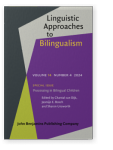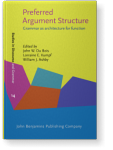Shanley E.M. Allen
List of John Benjamins publications for which Shanley E.M. Allen plays a role.
Book series
Psycholinguistic Approaches to Production and Comprehension in Bilingual Adults and Children
Edited by Leigh B. Fernandez, Kalliopi Katsika, Maialen Iraola Azpiroz and Shanley E.M. Allen
[Benjamins Current Topics, 117] 2021. vi, 272 pp.
Subjects Language acquisition | Multilingualism | Psycholinguistics | Theoretical linguistics
Psycholinguistic approaches to production and comprehension in bilingual adults and children
Edited by Maialen Iraola Azpiroz, Shanley E.M. Allen, Kalliopi Katsika and Leigh B. Fernandez
Special issue of Linguistic Approaches to Bilingualism 9:4/5 (2019) vi, 263 pp.
Subjects Cognition and language | Cognitive psychology | Language acquisition | Multilingualism | Psycholinguistics | Theoretical linguistics
The Acquisition of Reference
Edited by Ludovica Serratrice and Shanley E.M. Allen
[Trends in Language Acquisition Research, 15] 2015. vi, 339 pp.
Subjects Cognition and language | Language acquisition | Psycholinguistics | Semantics | Syntax | Theoretical linguistics
Aspects of Argument Structure Acquisition in Inuktitut
Shanley E.M. Allen
[Language Acquisition and Language Disorders, 13] 1996. xvi, 248 pp.
Subjects Language acquisition | Languages of North America | Syntax
2024 Bilingual children’s online processing of relative clauses: Evidence from heritage Greek Processing in Bilingual Children, Dijk, Chantal van, Jasmijn E. Bosch and Sharon Unsworth (eds.), pp. 446–475 | Article
Long-distance dependencies such as relative clauses (RCs) are known to be vulnerable in heritage grammars (e.g., Montrul, 2008). Previous studies in RC comprehension have shown that heritage language (HL) children show similar comprehension to monolingual children (Jia & Paradis, 2020), while… read more
2023 Proficient L2 readers do not have a risky reading strategy Linguistic Approaches to Bilingualism 13:6, pp. 854–872 | Article
Proficient first-language (L1) readers of alphabetic languages that are read left-to-right typically have a perceptual span of 3–4 characters to the left and 14–15 characters to the right of the foveal fixation. Given that second-language (L2) processing requires more cognitive resources, we… read more
2023 The dative alternation in German: Structural preferences and verb bias effects Ditransitives in Germanic Languages: Synchronic and diachronic aspects, Zehentner, Eva, Melanie Röthlisberger and Timothy Colleman (eds.), pp. 264–298 | Chapter
Many ditransitive events can be expressed in German using either the indirect object construction (IOC) or the prepositional object construction (POC). While most previous research on ditransitives in German has focused on the IOC, very little attention has been paid to the much rarer POC or to… read more
2022 The three-dot sign in language contact Discourse-pragmatic markers, fillers and filled pauses: Pragmatic, cognitive, multimodal and sociolinguistic perspectives, Beeching, Kate, Grant Howie, Minna Kirjavainen and Anna Piasecki (eds.), pp. 246–271 | Article
In this study, we investigate the three-dot sign as a discourse marker (DM) with textual, subjective and intersubjective discourse functions. As a graphical marker that is used across languages, the three-dot sign is especially suitable for comparative studies and dynamics in language contact.… read more
2021 Psycholinguistic approaches to production and comprehension in bilingual adults and children Psycholinguistic Approaches to Production and Comprehension in Bilingual Adults and Children, Fernandez, Leigh B., Kalliopi Katsika, Maialen Iraola Azpiroz and Shanley E.M. Allen (eds.), pp. 1–9 | Chapter
2021 Towards a methodological toolset for the psycholinguistics of translation: The case of priming paradigms Developments in Cognitive Translation and Interpreting Studies, Xiao, Kairong and Sandra L. Halverson (eds.), pp. 440–461 | Article
The manuscript provides readers with a basic methodological toolset for experimental psycholinguistic studies on translation. Following a description of key methodological concepts and the rationale behind experimental designs in psycholinguistics, we discuss experimental paradigms adopted from… read more
2019 Psycholinguistic approaches to production and comprehension in bilingual adults and children Psycholinguistic approaches to production and comprehension in bilingual adults and children, Azpiroz, Maialen Iraola, Shanley E.M. Allen, Kalliopi Katsika and Leigh B. Fernandez (eds.), pp. 505–513 | Introduction
2015 The role of cognitive accessibility in children’s referential choice The Acquisition of Reference, Serratrice, Ludovica and Shanley E.M. Allen (eds.), pp. 123–153 | Article
This chapter reviews the literature on preschool children’s sensitivity to cognitive accessibility in selecting linguistic forms to realize referents in speech. Both spontaneous speech and experimental production studies are reviewed, encompassing thirteen languages for monolingual children and… read more
2015 Introduction: An overview of the acquisition of reference The Acquisition of Reference, Serratrice, Ludovica and Shanley E.M. Allen (eds.), pp. 1–24 | Introduction
This chapter serves as an introduction to The Acquisition of Reference. The volume brings together influential recent research on the study of children’s comprehension and production of reference, with a focus on discourse-pragmatic approaches and cross-linguistic comparison. In this chapter, we… read more
2013 The acquisition of ergativity in Inuktitut The Acquisition of Ergativity, Bavin, Edith L. and Sabine Stoll (eds.), pp. 71–106 | Article
One potential challenge for children learning Inuktitut comes from the ergative case marking system, because of the contrast between the ergative system in morphology and the accusative system governing syntax. However, no studies have yet been published focusing on how Inuktitut-speaking children… read more
2009 Typological constraints on code mixing in Inuktitut–English bilingual adults Variations on Polysynthesis: The Eskaleut languages, Mahieu, Marc-Antoine and Nicole Tersis (eds.), pp. 273–306 | Chapter
Patterns of code mixing vary according to relative typology of the languages and sociolinguistics of the contact situation (e.g., Muysken 2000). We extend understanding of the factors involved by analyzing for the first time mixing between an isolating Germanic language (English) and a… read more
2008 Using corpora to examine discourse effects in syntax Corpora in Language Acquisition Research: History, methods, perspectives, Behrens, Heike (ed.), pp. 99–137 | Article
2007 How does linguistic framing of events influence co-speech gestures? Insights from crosslinguistic variations and similarities Gestural Communication in Nonhuman and Human Primates, Liebal, Katja, Cornelia Müller and Simone Pika (eds.), pp. 199–218 | Article
What are the relations between linguistic encoding and gestural representations of events during online speaking? The few studies that have been conducted on this topic have yielded somewhat incompatible results with regard to whether and how gestural representations of events change with… read more
2006 Formalism and functionalism working together? Exploring roles for complementary contributions in the domain of child null arguments Inquiries in Linguistic Development: In honor of Lydia White, Slabakova, Roumyana, Silvina Montrul and Philippe Prévost (eds.), pp. 233–255 | Article
2005 How does linguistic framing of events influence co-speech gestures? Insights from crosslinguistic variations and similarities Gestural Communication in Nonhuman and Human Primates, Liebal, Katja, Cornelia Müller and Simone Pika (eds.), pp. 219–240 | Article
What are the relations between linguistic encoding and gestural representations of events during online speaking? The few studies that have been conducted on this topic have yielded somewhat incompatible results with regard to whether and how gestural representations of events change with… read more
2003 Preferred Argument Structure in early Inuktitut spontaneous speech data Preferred Argument Structure: Grammar as architecture for function, Du Bois, John W., Lorraine E. Kumpf and William J. Ashby (eds.), pp. 301–338 | Article

















